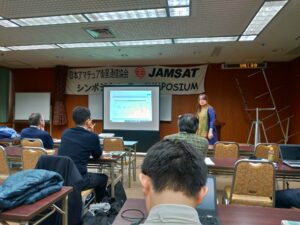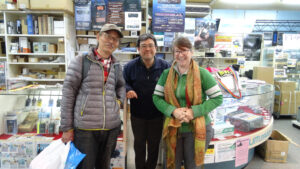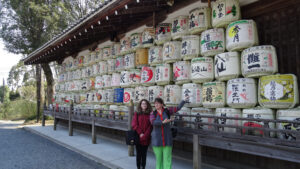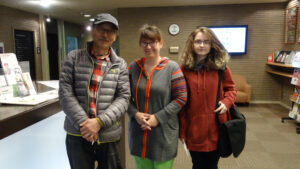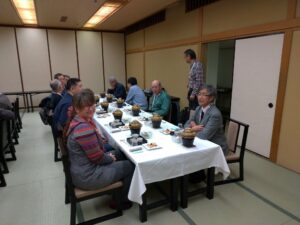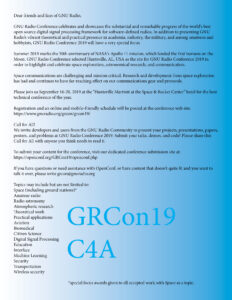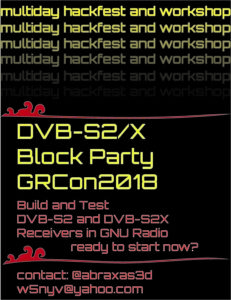HamCation 2022 Report
Paul Williamson (Remote Labs), Douglas Quagliana (P4DX), Michelle Thompson (ORI), Ed Wilson (M17), and Steve Miller (M17) represented the breadth of projects from Open Research Institute at HamCation 2022.
ORI’s “Tonight’s The Night: SDRs are HOT” booth made its first appearance in nearly two years. Available at the booth were stickers, pins, patches, shirts, consulting, and project updates. ORI’s “extra chair” seating area was appreciated by volunteers and visitors alike. Booth visitors heard about the successful DVB-S2X modem work from ORI and progress on the end-to-end demo of the entire satellite transponder chain. At Open Research Institute, it doesn’t work until it works over the air. Due to the efforts of a truly wonderful international open source team, the custom FPGA code is coming together very well, and Remote Labs continues to evolve. The Phase 4 Digital Multiplexing Transceiver project is on budget, on track, and highly likely to succeed. The return on investment is high. The team isn’t anywhere near done innovating, publishing, and enabling high-tech space aand terrestrial amateur radio work. If you want to be a part of this, or just follow along, visit https://openresearch.institute, go to “Getting Started”, and sign up for the Phase 4 Ground mailing list. This is “home base” for announcements from ORI.
Right beside ORI’s booth was the “future of amateur radio”, the M17 Project. Ed and Steve from M17 brought working hardware, firmware updates, and also demonstrated several different software implementations throughout the weekend. M17 held their weekly net on Friday live from the booth, gave away stickers, magnets, and pins, and captured the hearts of all who visited. You can get involved with this project at https://m17project.org
AmbaSat re-spin was a frequent topic of conversation. The five AmbaSat boards from ORI, which operate at 70cm, have been distributed to the firmware team, and they have begun development and are seeing success in university and hobbyist labs. The goal is to create a compelling application, put the hardware on a sounding rocket, apply for a launch license, and send this project to space in a way that makes the amateur community proud. While “AmbaSat Inspired Sensors” is ORI’s smallest received grant, it has by far the highest capability return on investment of any ORI project.
ORI and M17 booths were located in the North Hall. While the other buildings are larger and many consider them to be higher profile, booths in the North building are what you must walk by to get to the Information Booth and Prize Booth. Since the vast majority of participants visit this part of the show, it is, in our humble opinion, the best possible location.
Michelle Thompson (W5NYV) presented about Digital Communications Technology at the ARRL Expo Technology Track held on Thursday at a conference center near Seaworld. There were four tracks of presentations at the Expo: Contesting, Handbook, Technology, and Emergency Communications.
Michelle reported a positive, enthusiastic, and engaged audience for her ARRL Technology Track talk, and has high hopes that ARRL will continue doing events like this moving forward. She discussed ORI’s Polar Code initiative, successful regulatory and legal work, why open source LDPC work is so important to amateur radio, the four fundamental components to digital communications, and why the M17 protocol was selected as ORI’s satellite uplink protocol for the P4DX transponder project. Michelle invited M17 principals to speak about their work, and opened the floor for questions and comments from the many highly competent and curious technical hams that were in attendance. Subjects covered ranged from asynchronous computing to concatenated coding. The rumors about toilet paper being a fundamentally important part of this presentation are entirely true.
ORI organized a Friday forum track for Clearspan Tent #1 that ran from 11:15am until closing. HamCation was extremely generous in giving us time to present work from a wide variety of people. Here’s our lineup for 2022.
11:15 am
Understanding and Changing Amateur Radio Regulation / Open Source Digital HTs are Real! by Bruce Perens (K6BP)
12:30 pm TAPR – TangerineSDR Update, or How to build an SDR without any parts by
Scotty Cowling (WA2DFI)
1:45 pm M17 Project by Ed Wilson, Steve Miller (N2XDD, KC1AWV)
3:00 pm GNU Radio work at ORI / FreeDV HF Voice Update 2022 by Douglas Quagliana, Mel Whitten (KA2UPW, K0PFX)
3:00 pm Society of Amateur Radio Astronomy SARA by Tom Crowley (KT4XN)
At both the Expo and HamCation, ARRL set the pace this year for satellite talks and satellite demonstrations, with a video (please see https://www.youtube.com/watch?v=fhyUbC_o1JM&ab_channel=ARRLHQ) providing practical examples of amateur satellite operations. Patrick Stoddard (WD9EWK) gave a tutorial on satellite operations at the ARRL Expo in the Handbook Track. Amateur satellite was very well supported from ARRL this year, and we have heard this will continue to strengthen going forward.
With some optimism, ORI looks forward to returning to in-person events. The next planned in-person event is DEFCON (https://defcon.org/). Last year, DEFCON was held in person. Proof of vaccination was required. Masks were required. It was a highly successful and enjoyable event. This year, for 2022, ORI will be represented in DEFCON villages and activities. We are looking at applying for M17 to be part of Demo Labs, multiple radio links between villages to demonstrate a wide variety of technology, and presentations about the R&D that we do.
If you would like to be a part of this, and we do need you, then please join the Slack channel for DEFCON planning. Quite a bit of work is underway already. The goal for DEFCON 2022 is over the air demonstrations, outreach, fun, swag, and supporting our friends at all the villages we’ve been involved with over the years.
DEFCON is run very differently from traditional amateur radio conventions. The most significant practical difference is that DEFCON has a written code of conduct, and those written community standards and policies are enforced. It has a very diverse and very interdisciplinary attendance. Unlike many technical or hobby conferences, participation in the DEFCON community is possible year-round through participation in local groups that meet monthly.
DEFCON is a very large event, with attendance of over 30,000.
DEFCON is devoted to a very broad spectrum of experimental, commercial, and open source work. Participation by the government, industrial, information security, hacker, hobbyist, and scientific communities has steadily grown over the past 30 years.
The next virtual event for Open Research Institute is Ham Expo, 12-13 March 2022. Andre Suoto will have an excellent talk about our open source LDPC encoder for FPGAs and ASICs. This is in the main track. We will have a wide variety of work and projects represented at our booth, which is in the vendor hall. Open Research Institute is a non-profit sponsor of Ham Expo. We’ll have friendly and accessible “office hours” during the event.
